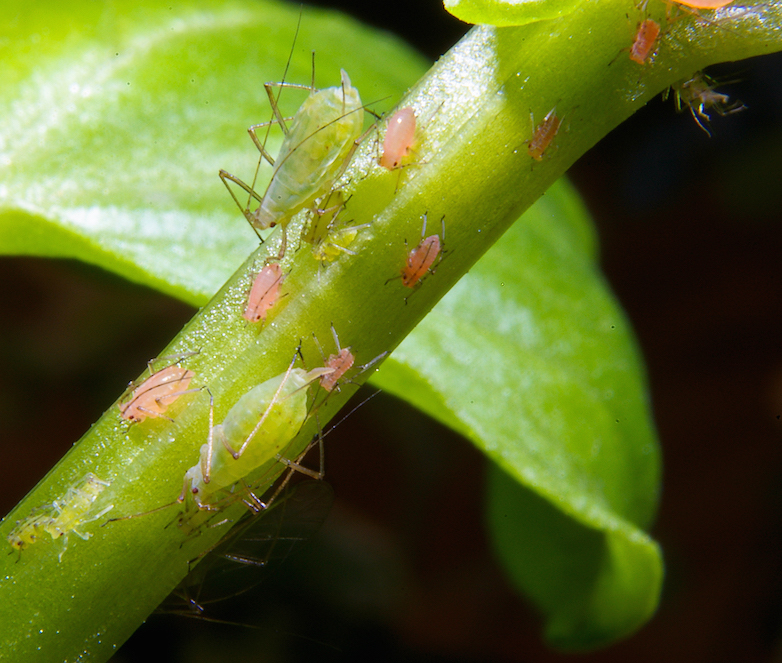Pea Aphid
Acyrthosiphum pisum

Pink and green morphs
Pea aphids are large green aphids, the adults up to about almost 1/4 inch long, with long cornicles (tail pipes) that are blackish towards the tip. Occasionally, pink forms may also may be present. The pea aphid can be distinguished from the blue alfalfa aphid by the narrow dark band on the tip of the third antennal segment, whereas the blue alfalfa aphid's third antennal segment is uniformly brown. Winged pea aphids have a light brown thoracic area, while this region on the blue alfalfa aphid is dark brown. In general the pea aphid is larger than the blue alfalfa aphid and lacks its dark blue-green color.
The pea aphid is distributed throughout the alfalfa-growing areas of the United States. In warm winters, it can remain active throughout the winter, at least in southern Kansas, but under colder conditions it may overwinter in the egg stage. The tiny black eggs are glued to the stems and fallen leaves of alfalfa and clover in the fall. Hatching occurs in the early spring, and after one or two generations, most nymphs will develop wings. These winged females will migrate to other fields and start new colonies, producing nymphs asexually, like their wingless mothers. The entire life cycle takes about 8-12 days, depending on temperature, and females are usually still reproducing as daughters begin giving birth to granddaughters. Populations are this capable of exponential growth in the absence of sufficient biocontrol agents.
Large pea aphid populations usually develop in the spring, but sometimes also in the fall. The aphids suck juices from alfalfa leaves, petioles, stems, and flower buds, congregating on the growing tips of the plants. Heavy pea aphid feeding will cause alfalfa to turn yellow and wilt, and can also cause stunting, so that plants have small leaves and spindly stems. The tops of the plants may die back when subjected to heavy feeding. Large infestations in the spring can delay the first cutting or cause its complete loss, and also reduce the vigor of plants and the quality of later cuttings. When alfalfa growth is retarded, weeds often take over and crowd out the alfalfa. Prolonged periods of cool temperatures (50 to 60°F range) and dry conditions are conducive to the development of heavy pea aphids populations. Keep fields under close observation during periods of slow growth. Varieties of alfalfa exist that have varying degrees of resistance to pea aphids, so variety selection can be an important management consideration.
Evaluating plant vigor is often the key to determining the need to treat for this insect. Heavily infested plants may turn yellow and wilt, usually during March, April and May. Closely monitor fields early in the season during periods of slow growth. Randomly select complete stems throughout the field and count the number of blue alfalfa aphids per stem and all parasitized (mummified) or diseased (brown and flattened) aphids. Continue this procedure until you have sampled at least 20 to 30 stems. Calculate the average number of healthy aphids per stem and the average of diseased or parasitized aphids per stem. Then measure each stem and calculate the average stem length. Also count and record all aphid predators such as ladybird beetles and lacewings.
Treatment Thresholds: Control decisions should be based on the maturity of the alfalfa, the size of the aphid population, and the number of natural control agents present. Alfalfa can tolerate low numbers of aphids without much sign of injury. Very light populations of aphids can even be considered beneficial because they provide a food source for ladybugs and other predators and parasites. However, high numbers of aphids can cause yellowing, wilting and stunting of plants. Fifty pea aphids per stem on 10 inch tall alfalfa would be cause for alarm if predators and diseased or parasitized aphids are scarce. On 20-inch tall alfalfa, twice as many aphids per stem would be required before treatment is justified. Evaluating relative plant vigor is often the key to determining the need to treat for this insect. Treatment Options: One of the best methods to reduce the impact of pea aphids is to select varieties with high levels of pea aphid resistance. Early cutting may be an option when heavy infestations develop close to cutting time. Our data on efficacy of insecticides for pea aphid control in Kansas shows that some products may provide effective control of pea aphids even at the lowest recommended rates.
Please refer to the most recent Alfalfa Insect Management Guide for control options.
Page last updated 4/16/2024 by J.P. Michaud.